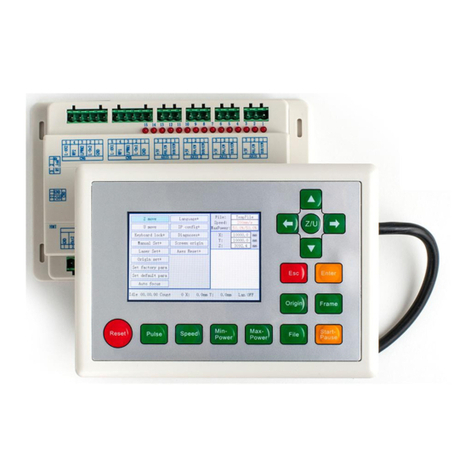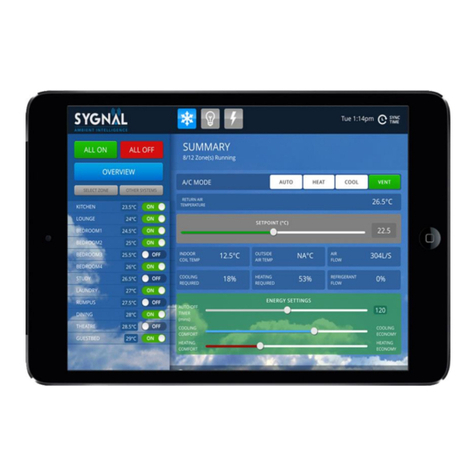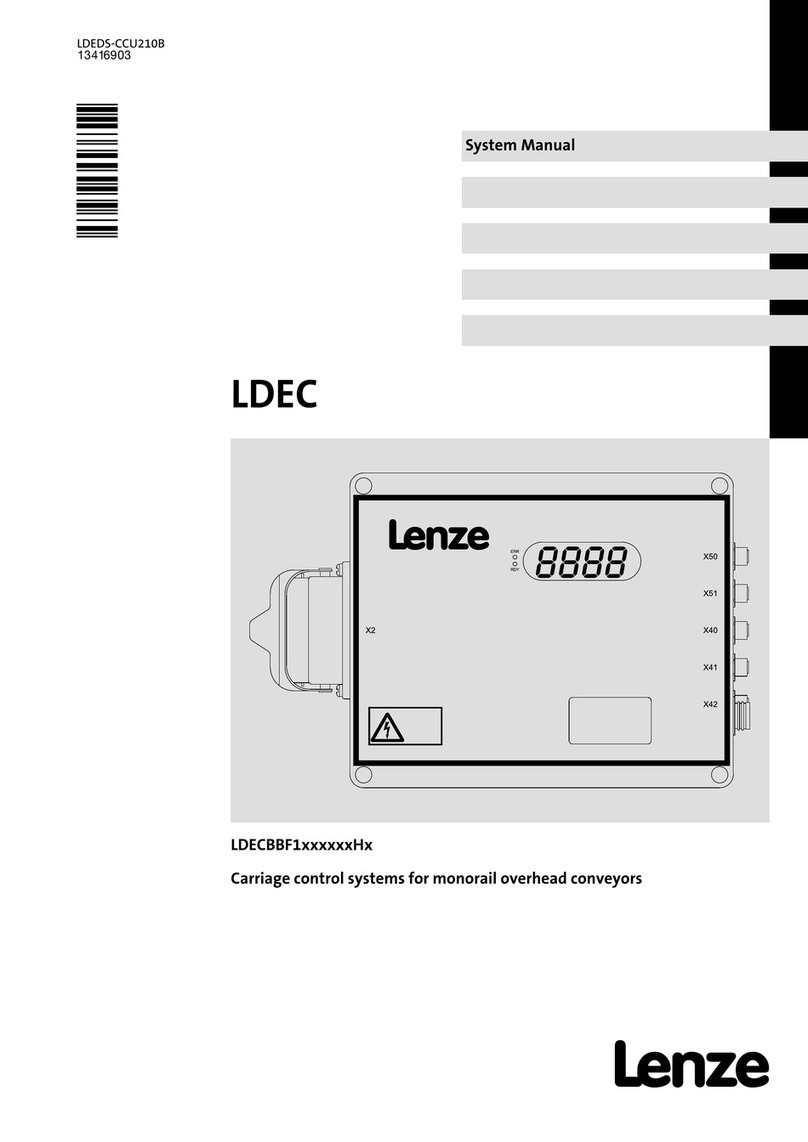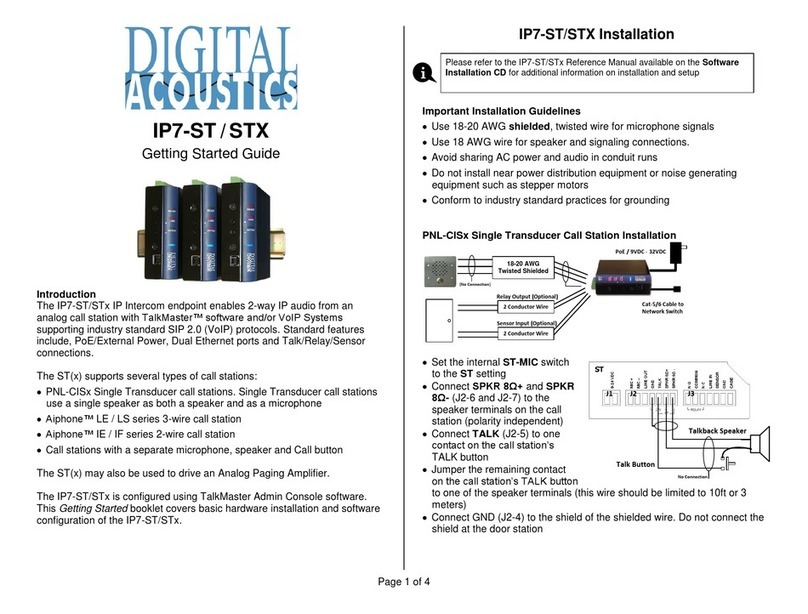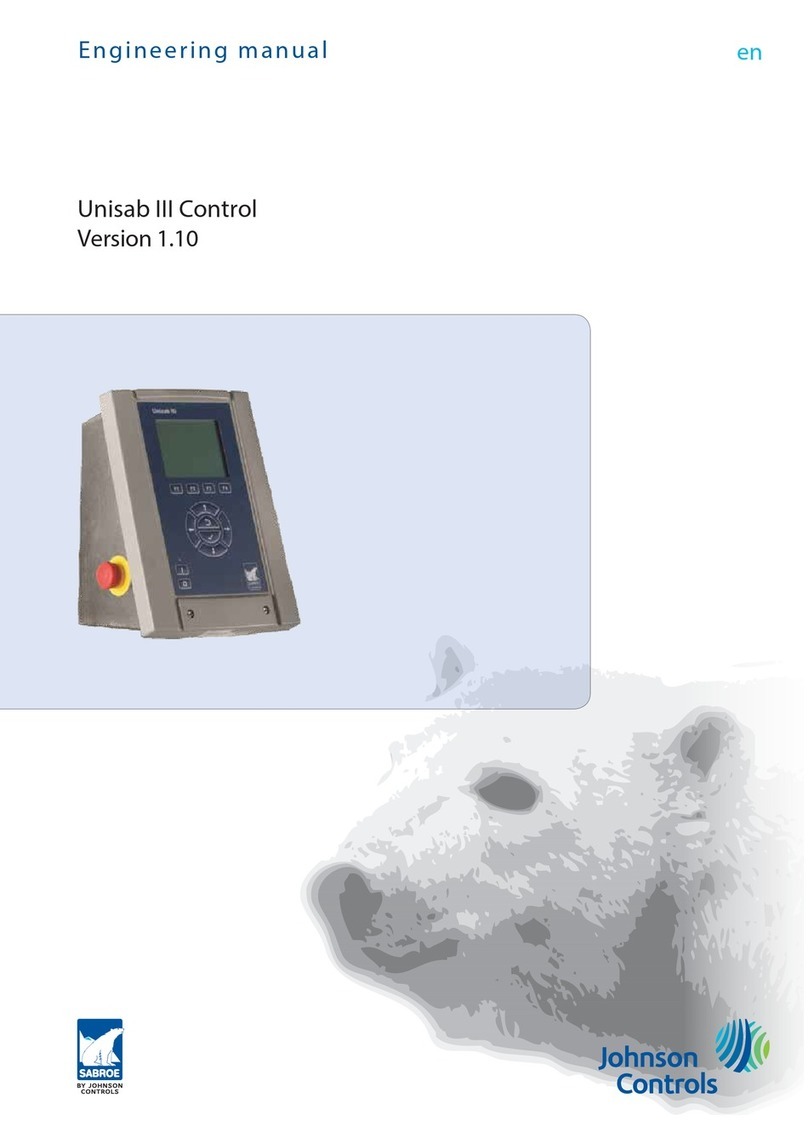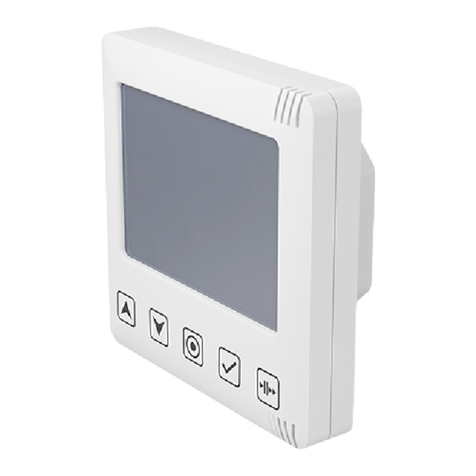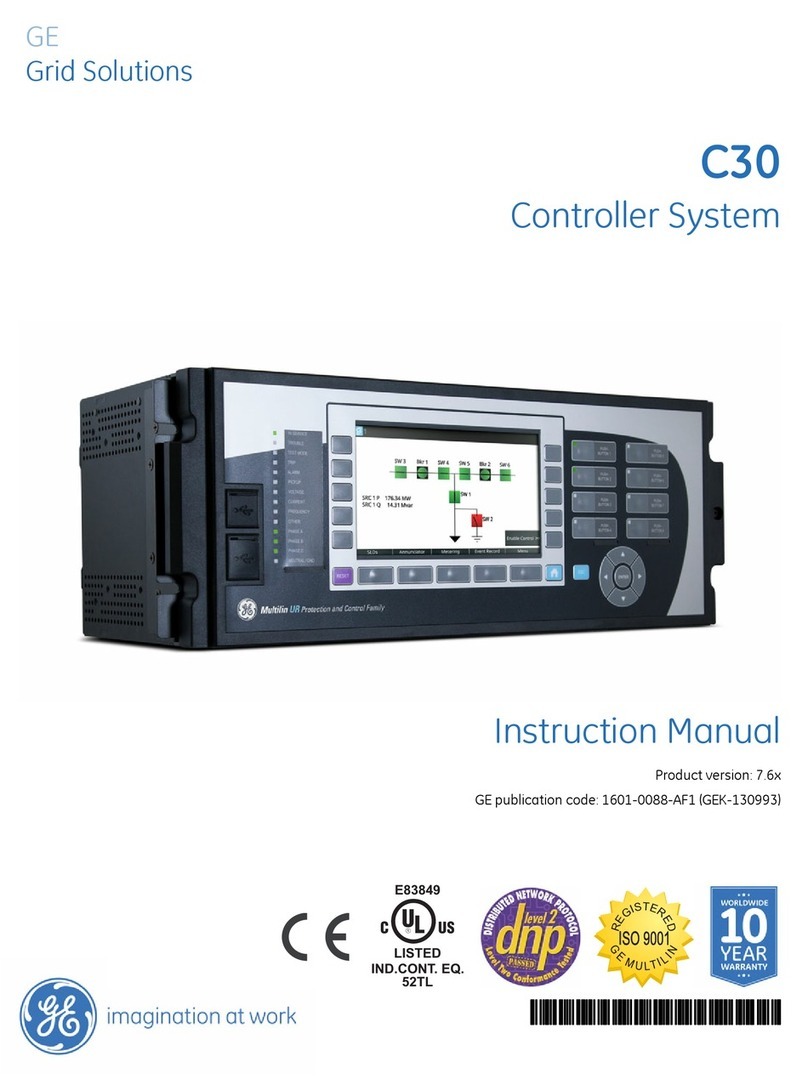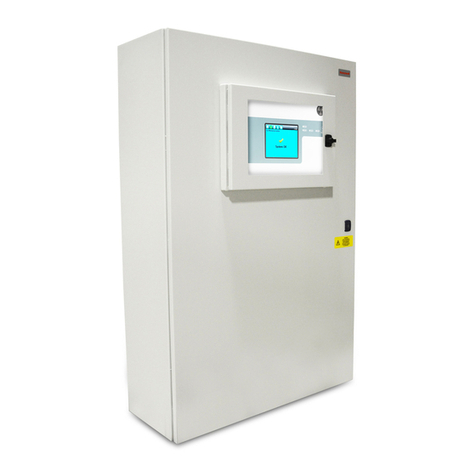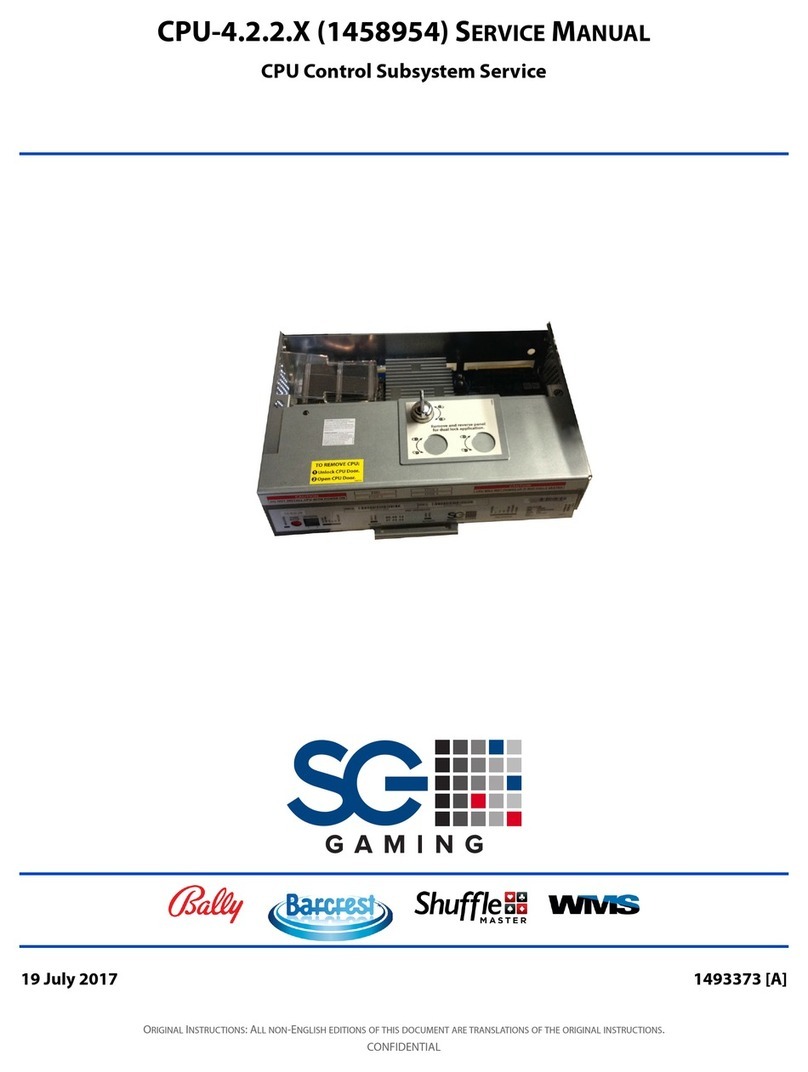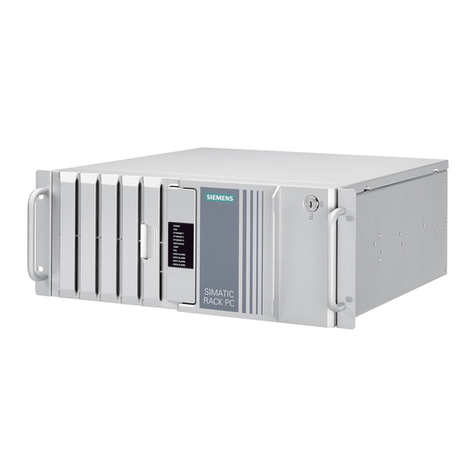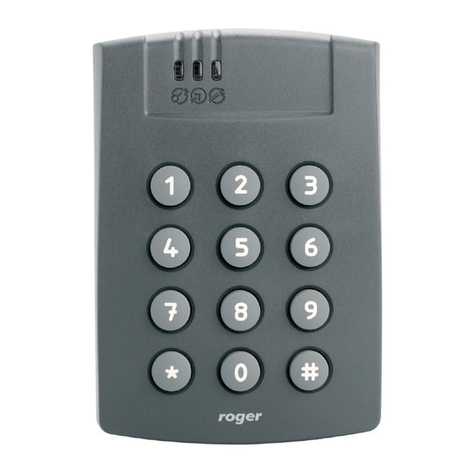smart home Securelinc Operating instructions

DE5457P 1
SECURELINC
SECURELINCSECURELINC
SECURELINC
Fully Supervised Wireless Alarm Control System Programming Guide
TABLE OF CONTENTS
TABLE OF CONTENTSTABLE OF CONTENTS
TABLE OF CONTENTS
1. INTRODUCTION............................................................2
1.1 General Guidance ..............................................2
1.2 Accessing the Installer’s Menu...........................2
2. SETTING A NEW INSTALLER CODE .........................3
3. ENROLLING WIRELESS DEVICES AND KEYFOBs..3
3.1 General Guidance ................................................3
3.2 Wireless Devices .................................................3
3.3 Keyfob Transmitters .............................................3
3.4 Deleting Device and Keyfob IDs ..........................4
4. DEFINING ZONE TYPES .............................................5
4.1 Preliminary Guidance ...........................................5
4.2 Zone Definition Procedure ...................................5
5. DEFINING CONTROL PANEL PARAMETERS ...........7
5.1 Preliminary Guidance ...........................................7
5.2 Entry Delays .........................................................8
5.3 Exit Delay .............................................................8
5.4 Bell Time ..............................................................8
5.5 Abort Time............................................................8
5.6 Alarm Cancel Time...............................................8
5.7 Quick Arming........................................................8
5.8 Forced Arming......................................................9
5.9 Restart Exit...........................................................9
5.10 Piezo Beeps .......................................................9
5.11 Trouble Beeps ....................................................9
5.12 Panic Alarm ........................................................9
5.13 Swinger Stop ......................................................9
5.14 Cross Zoning ......................................................9
5.15 Supervision Interval............................................9
5.16 AUX Button.........................................................9
5.17 Jamming Detection.............................................9
5.18 Two-Way Voice ...............................................10
5.19 PGM / X-10 Time..............................................10
5.20 Lighting Lockout Time ......................................10
5.21 Latchkey Arming...............................................10
5.22 “Not Active” Time..............................................10
5.23 Back Lighting....................................................10
5.24 Duress Alarm (ambush) ...................................10
5.25 Piezo Siren .......................................................10
6. DEFINING COMMUNICATION PARAMETERS.........11
6.1 Preliminary Guidance .........................................11
6.2 Dialing Method ...................................................12
6.3 Phone Line Test Interval.................................... 13
6.4 First Central Station Telephone......................... 13
6.5 First Account No. ............................................... 13
6.6 Second Central Station Telephone.................... 13
6.7 Second Account No........................................... 13
6.8 Report Format.................................................... 13
6.9 4/2 Pulse Rate ................................................... 13
6.10 Events Reported to Central Stations ............... 13
6.11 Dialing Attempts .............................................. 13
6.12 First Private Telephone No.............................. 13
6.13 Second Private Telephone No......................... 14
6.14 Third Private Telephone No............................. 14
6.15 Telephone Message Type ............................... 14
6.16 Private Tel. Dialing Attempts ........................... 14
6.17 Events Reported to Private Telephones.......... 14
6.18 Telephone Acknowledge ................................. 14
6.19 Pager Telephone Number ............................... 14
6.20 Pager’s PIN No................................................ 14
6.21 Reporting to a Pager ....................................... 14
6.22 Recent Closure................................................ 14
6.23 Remote Access ............................................... 14
6.24 Downloader Code............................................ 15
7. DEFINING OUTPUT PARAMETERS ........................ 15
7.1 Preliminary Guidance ........................................ 15
7.2 PGM Output Control .......................................... 16
7.3 Controlling the X-10 Units.................................. 16
8. RECORDING SPEECH.............................................. 17
8.1 Mode Description and Activation ....................... 17
8.2 Recording Procedure......................................... 17
9. DIAGNOSTIC TEST................................................... 17
9.1 Mode Description and Activation ....................... 17
9.2 Test Procedure .................................................. 18
10. USER FUNCTIONS................................................... 18
11. READING THE EVENT LOG .................................... 18
11.1 Event Log Description ..................................... 18
11.2 Reading Procedure.......................................... 19
11.3 Erasing the Event Log ..................................... 19
APPENDIX A. EVENT CODES ....................................... 20
Important Message to the Installer
If you re-program a system already in use, all previous system status will be erased upon quitting the
installer menu. Be sure to conduct a full walk test, including all windows and doors, to allow the control
panel to re-capture the system status.
SMARTHOME.COM™ 1-800-SMART-HOME 949-221-9200 http://www.smarthome.com Order #73902

2DE5457P
1
11
1. INTRODUCTION
. INTRODUCTION. INTRODUCTION
. INTRODUCTION
1.1 General Guidance
We recommend to program the SECURELINC on the work
bench before actual installation. Operating power may be
obtained from the backup battery or from the AC mains.
The installer’s menu is accessible only to those who know
the installer’s code, which is 9!9!9!9by factory
default.
Obviously, you are expected to use this code only once for
gaining initial access, and replace it with a secret code
known only to yourself (see Section 2).
You will mainly use 5 control pushbuttons throughout the
entire programming process:
- to advance within a given menu.
- to retreat within a given menu.
-to go down one level in the programming
structure or to confirm data.
- to go up one level in the programming structure.
- instant return to the installer menu (top level).
The sounds you will hear while programming are:
- Single beep, heard whenever a key is pressed.
- Double beep, indicates automatic return to the
normal operating mode (by timeout).
☺-Happy Melody (- - - –––), indicates successful
completion of an operation.
#- Sad Melody (–––––), indicates a wrong move
or rejection.
1.2 Accessing the Installer’s Menu
To access the installer’s menu and navigate within it,
refer to Figures 1 and 2 and proceed as follows:
A. Click the <NEXT> button until the display reads:
INSTALLER MODE
B. Click <OK> to select the installer’s mode. The control
panel will prompt you for the installer code.
C. Enter the valid installer code (9!9!9!9)if this is the
first time you access the installer menu. The “Happy
Tune” will sound if the code is correct and the display
will change to:
1.NEW INSTL CODE
You have now gained access to the first item on the
installer menu. Detailed instruction on how to deal with
each item is given in sections 2 through 10 below.
Note: At this point refer to Figure 2, that takes over
where Figure 1 left off.
D. Click <NEXT> to go up in menu item numbers and
<BACK> to go down in menu item numbers.
E. To quit the installer’s menu, click <AWAY>. This will
take you directly to “<OK> TO EXIT”.
F. Click <OK> to return to the normal operating mode.
Figure 1. Gaining Access to the Installer’s Menu
Figure 2. Navigating within the Installer Menu
SMARTHOME.COM™ 1-800-SMART-HOME 949-221-9200 http://www.smarthome.com Order #73902

DE5457P 3
2
22
2. SETTING A NEW INSTALLER CODE
. SETTING A NEW INSTALLER CODE. SETTING A NEW INSTALLER CODE
. SETTING A NEW INSTALLER CODE
A. Having successfully gained access to the installer
menu (see Section 1), the display will read:
1.NEW INSTL CODE
B. To change the installer code, click <OK>. The old code
will appear (the factory default if this is the first change):
INST. CODE 9999
The cursor will flash on the first digit of the code.
C. Enter a new 4-digit code. After entering the 4th digit, the
cursor will stop flashing.
Attention! Do not use “0000” - this code is invalid.
D. Click <OK>. The “Happy Tune” will sound and the
display will revert to:
1.NEW INSTL CODE
E. You may now click <NEXT> or <BACK> to select any
other item on the installer’s menu.
3
33
3. ENROLLING WIRELESS DEVICES AND KEYFOB TRANSMITTERS
. ENROLLING WIRELESS DEVICES AND KEYFOB TRANSMITTERS. ENROLLING WIRELESS DEVICES AND KEYFOB TRANSMITTERS
. ENROLLING WIRELESS DEVICES AND KEYFOB TRANSMITTERS
3.1 General Guidance
The ENROLLING mode has two sub-modes:
• ENROLL WL DEVICE (wireless devices)
• ENROLL KEYFOB (multi-button CodeSecure transmitters)
Refer to Paragraphs 3.2 and 3.3 for enrolling procedures.
Attention! CodeSecure transmitters are mainly used for
arming/disarming and can not be enrolled to zones. For
enrolling to zones, use only non-CodeSecure
wireless devices.
3.2 Wireless Devices
Wireless devices include various wireless PowerCode
detectors and hand-held special-task transmitters. Your
control panel must recognize the unique identification
code (ID) of each such device in order to supervise them,
receive their signals and respond accordingly.
Before anything else, gather all the devices that you intend
to enroll, and make sure they all have batteries installed.
•
••
•
The lens at the front of PIR and dual-
technology sensors should be masked to
prevent inadvertent transmission.
•
Use rubber bands to bind magnetic contact trans-
mitters together with their magnets, to prevent them
from sending out alarm transmissions.
To enroll wireless devices, go through the following steps:
A. Upon gaining access to the installer menu (see Section
1), the display will read “1. NEW INSTL CODE”.
B. Click <NEXT>. The enrolling mode will be selected and
the display will show:
2. ENROLLING
C. Click <OK> to select the “enroll wireless devices”
sub-mode. The display will change to:
ENROLL WL DEVICE
D. Click <OK> again. The display will read:
Zone No : __
E. Suppose that the wireless device you are about to
enroll is to be installed in Zone No. 4. Assuming that
zone No. 4 is free - no device has yet been enrolled to
it, just enter <0>$<4>. The display will change to:
Zone No: 04
The clear space at the far right tells you that the zone is
free - no wireless device has been enrolled to it as yet.
F. Click <OK>. The display will prompt you to initiate a
transmission from the chosen wireless device:
TRANSMIT NOW
G. Initiate transmission from the chosen device by:
• Removing the mask from the lens of the PIR motion
detector, or
• Separating the magnet from the magnetic contact
sensor, or
• Pressing the button of the hand-held miniature
transmitter, or
• Pressing the test button of the smoke detector.
H. In response to the transmitted signal, the “Happy Tune”
(- - - ––– ) will sound and the display will change to:
Zone No: 04
A dark box will appear at the far right, indicating that
the chosen device has been enrolled to Zone No. 4.
Note: If the same device is already enrolled to another
zone, the “Happy Tune” will sound twice in succession.
I. From this point on, you may continue in several
different directions:
• If you wish to enroll another device to
another zone, select the other zone by:
-Clicking <NEXT> to go up (5%6%7.....)
- Clicking <BACK> to go down (3%2%1.....)
-Clicking <HOME>%<desired zone #>.
After that, proceed as in the example above.
• To delete a device ID, refer to Para. 3.4.
• To select the Enroll Keyfob sub-mode,
click <HOME> and then <NEXT>.
• To return to the main menu, click <AWAY>.
This will bring back the display:
<OK> TO EXIT
You may now review and select any other
mode on the installer’s menu (by clicking
<NEXT> or <BACK>).
3.3 Keyfob Transmitters
Keyfob transmitters are multi-button wireless units of the
CodeSecure™ type. Eight system users carry them on
their person to exercise better, quicker and safer control
over various system functions. Your control panel must
recognize the unique identification code (ID) of each
such keyfob in order to respond to commands
transmitted by them.
Before anything else, gather up all keyfob units you intend
to enroll, and make sure they all have batteries installed.
Keyfob transmitter enrolling involves the following steps:
SMARTHOME.COM™ 1-800-SMART-HOME 949-221-9200 http://www.smarthome.com Order #73902

4DE5457P
A. Perform Steps A through C in Para. 3.2 above, until the
display reads:
ENROLL WL DEVICE
B. Click <NEXT>. The display will read:
ENROLL KEYFOB
C. Click <OK>. The display will read:
Keyfob No: _
D. Suppose that the Keyfob you are about to enroll is to be
designated as Keyfob No. 5. Assuming that memory
location No. 5 is free - no keyfob has yet been enrolled
to it - click the <5> key. The display will change to:
Keyfob No: 5
The clear space at the far right tells you that the
memory location is free.
E. Click <OK>. The display will prompt you to initiate a
transmission from the chosen wireless device:
TRANSMIT NOW
F. Initiate a transmission from the chosen keyfob by
pressing any one of its pushbuttons. In response, the
“Happy Tune” (- - - –––) will sound and the display will
change to:
Keyfob No: 5
A dark box will appear at the far right, indicating that
the chosen Keyfob has been enrolled as Keyfob No. 5.
Note: If the same keyfob is already enrolled elsewhere,
the “Happy Tune” will sound twice in succession.
G. From this point on, you may continue in several
different directions:
• If you wish to enroll another keyfob, select
the desired number by:
-Clicking <NEXT> to go up (6%7%8.....)
- Clicking <BACK> to go down (4%3%2....)
-Clicking <HOME> %<desired zone #>.
After that, proceed as in the example above.
• To delete keyfob IDs, refer to Para. 3.4.
• To return to the main menu, click
<AWAY>. This will bring back the display:
<OK> TO EXIT
You may now review and select any other
mode on the installer’s menu (by clicking
<NEXT> or <BACK>).
3.4 Deleting Device and Keyfob IDs
Occupied zones or keyfob memory locations must be
cleared (enrolled ID must be deleted) before enrolling a
new ID. To delete an existing ID, proceed as follows:
A. Select the desired zone or memory location. If, for
example you selected Zone No. 15, or keyfob No. 8,
the display will read:
Zone No. 15
or, in the other case:
Keyfob No. 8
B. Click <OK>. The display will change to:
<OFF> to delete
C. Click <OFF>. The display will change to:
Zone No. 15
or, in the other case:
Keyfob No. 8
Note that the dark box at the far right has disappeared.
It is now possible to enroll a new ID. It is also possible
to leave the cleared zone or memory location free, and
simply exit to the main menu.
SMARTHOME.COM™ 1-800-SMART-HOME 949-221-9200 http://www.smarthome.com Order #73902

DE5457P 5
4
44
4. DEFINING ZONE TYPES
. DEFINING ZONE TYPES. DEFINING ZONE TYPES
. DEFINING ZONE TYPES
4.1 Preliminary Guidance
This mode allows you to attribute one of 9 zone types to
any one of the 29 wireless zones offered by the
SECURELINC. In addition it allows you to assign a name to
each zone and determine whether the zone will operate as
a chime zone while the system is in the disarmed state.
A list of factory defaults is printed on the following page.
You may fill out the blank columns even before you start
and proceed to program according to your own list.
To reach the DEFINE ZONES mode, proceed as follows:
A. Upon gaining access to the installer menu (see Section
1), the display will read “1. NEW INSTL CODE”.
B. Click <NEXT> twice. The 3rd mode will be selected:
3. DEFINE ZONES
Should you wish to get an overall view of the entire
zone definition process, refer to Figure 3. You may
even use the chart as your only guide along the
programming process, instead of going through the
written step-by-step procedure.
Remember!
1. A delay zone is also a perimeter zone by definition.
2. All interior zones become follower zones during the exit
and entry delays.
ZONE NAME LIST
Attic
Back door
Basement
Bathroom
Bedroom
Child room
Closet
Den
Dining room
Downstairs
Emergency
Fire
Front door
Garage
Garage Door
Guest room
Hall
Kitchen
Laundry room
Living room
Master bath
Master Bdrm
Office
Upstairs
Utility room
Yard
Custom 1
Custom 2
Custom 3
Figure 3. DEFINE ZONES Flow Chart
4.2 Zone Definition Procedure
Once “3. DEFINE ZONES” is viewed, proceed as follows:
A. Click <OK>. The display will read:
Zone No. __
B. Suppose that you wish to define (or re-define) Zone No.
7. All you have to do is select the zone by entering
<0>$<7>, thereby changing the display to:
Zone No. 07
If there is no dark box at the far right, the zone has not
learned a device ID as yet. If there is a dark box, the
zone is already linked to a specific wireless device.
C. Click <OK>. The display will read:
Z07: TYPE _
D. You can now enter the number of a specific zone
definition (see list in Figure 3) and click <OK>. If, for
example, you enter <5>$<OK>, the display will read:
5.24h silent
Note: If you click <OK> without entering a number, the
display will show the current definition of the selected
zone, with a dark box at the far right. You may then
review all definitions by clicking <NEXT> repeatedly.
E. To accept the definition on display, click <OK>. A dark
box will appear at the far right:
SMARTHOME.COM™ 1-800-SMART-HOME 949-221-9200 http://www.smarthome.com Order #73902

6DE5457P
5.24h silent
F. Click <OK> once more to confirm. The “Happy Tune”
will sound, and your selection will be memorized. The
display will then change to:
Z07:NAME _
G. At this point, enter the serial number of the zone name
you wish to attach to zone No. 7 from the list of 29
available names (see list in Figure 3).
Note: If you click <OK> without entering a number, the
display will show the current name of the selected
zone, with a dark box at the far right. You may then
review all names by clicking <NEXT> repeatedly.
H. If you enter a number (say 13), the display will read:
Front door
I. Click <OK> to accept this name - a dark box will appear
at the far right. Click <OK> again to confirm. The
“Happy Tune” will sound, your selection will be saved
and the display will change to:
Z07:CHIME
J. Click <OK>. You are about to determine whether this
zone will be a chime zone or not. The display will read:
chime on
or: chime off
You can toggle the display between CHIME ON and
CHIME OFF by clicking <NEXT>.
K. Click <OK> once if you approve of the already selected
option - the “Happy Tune” will sound. Alternatively, click
<OK> twice while the other option is viewed. The
“Happy Tune” will sound and the display will revert to:
Zone No. 07
L. From this point on, you may continue in several
different directions:
- Click <NEXT> to go up (8%9%10.....)
- Click <BACK> to go down (6%5%4.....)
Repeat Steps C through K above for all
other zones that you plan to use.
• To return to the main menu, click
<AWAY>. This will get you back to:
<OK> TO EXIT
You may now review and select any other
mode on the installer’s menu (by clicking
<NEXT> or <BACK>).
DEFAULT AND PROGRAMMED ZONE DEFINITIONS
Zone Type Zone Name
Default Programmed Default Programmed
1 Delay 1 Front door
2 Delay 1 Garage
3 Delay 2 Garage door
4 Perimeter Back door
5 Perimeter Child room
6 Interior Office
7 Interior Dining room
8 Perimeter Dining room
9 Perimeter Kitchen
10 Perimeter Living Room
11 Interior Living Room
12 Interior Bedroom
13 Perimeter Bedroom
14 Perimeter Guest Room
15 Interior Master Bedroom
16 Perimeter Master Bedroom
17 Perimeter Laundry room
18 Perimeter Master Bathroom
19 Perimeter Basement
20 Fire Fire
21 Fire Fire
22 Emergency Emergency
23 Emergency Emergency
24 24 h / silent Basement
25 24 h / silent Office
26 24 h / audible Attic
27 24 h / audible Den
28 non-alarm Yard
29 non-alarm Hall
30 non-alarm Utility room
* Note: All zones are non-chime by default. Enter your own choice in the last column and program accordingly.
Zone No. Chime Y/N? *
SMARTHOME.COM™ 1-800-SMART-HOME 949-221-9200 http://www.smarthome.com Order #73902

DE5457P 7
5
55
5. DEFINING CONTROL PANEL PARAMETERS
. DEFINING CONTROL PANEL PARAMETERS. DEFINING CONTROL PANEL PARAMETERS
. DEFINING CONTROL PANEL PARAMETERS
5.1 Preliminary Guidance
A. Mode description
This mode allows you to customize the control panel and
adapt its characteristics and behavior to the requirements
of the particular user.
Should you wish to get an overall view of the entire
programming process, refer to the programming chart
in Figure 4. You may even use the chart as your only
guide along the programming process, instead of
going through the written step-by-step procedure.
Figure 4. DEFINE PANEL Flow Chart
SMARTHOME.COM™ 1-800-SMART-HOME 949-221-9200 http://www.smarthome.com Order #73902

8DE5457P
B. Gaining access to the “Define Panel” Memory
Locations
To reach the DEFINE PANEL mode, proceed as follows:
&
&&
&Upon gaining access to the installer menu (see Section
1), the display will read “1. NEW INSTL CODE”.
&
&&
&Click <NEXT> until the 4th mode is displayed:
4. DEFINE PANEL
&
&&
&Click <OK>. The first memory location will be selected
and displayed:
01:ENTRY DELAY 1
&
&&
&Click <NEXT> or <BACK> until you reach the memory
location you wish to access (see rectangles 01 to 25 in
Figure 4).
C. Programming Method
The ”multiple choice” programming method is applied
here. Once a memory location is selected, its number and
name are displayed as shown in the following example:
03:EXIT DELAY
When you click <OK>, the currently saved option will be
displayed with a dark selection box at the far right of the
display:
exit delay 45s
If you approve of this option, click <OK>. The “Happy
Tune” will sound and the display will revert to the number
and name of the presently selected memory location.
If you do not approve, review the other options by clicking
<NEXT> or <BACK> repeatedly. Options that are not
saved will have a clear space at the far right, as shown:
exit delay 90s
To select an option, click <OK>. A dark box will appear at
the far right of the display.
Clicking <OK> once more will cause your selection to be
saved - the “Happy tune” will sound and the number and
name of the presently selected memory location will be
re-displayed. Click <NEXT> or <BACK> to select
another memory location.
5.2 Entry Delays
Two different entry delays allow the user to enter the
protected site (while the system is in the armed state) via
2 specific doors and routes without causing an alarm.
Following entry, the user must disarm the control panel
before the entry delay expires. Slow-rate warning beeps
will start sounding once the door is opened. This will
continue until the last 10 seconds of the delay, through-
out which the beeping rate will increase.
Locations No. 1 (entry delay 1) and 2 (entry delay 2)
allow you to program the length of these delays.
Available options for each delay are: 00, 15, 30, 45, 60,
180 and 240 seconds.
In UL installations, these delays must be 45 s max.
Upon selecting Location No. 01, The display will read:
01:ENTRY DELAY 1
select the desired option as outlined in Para. 5.1 C above.
When done, Click <NEXT> to select Location No. 2.
Continue the same way as in location 1. When done, Click
<NEXT> to select Location 3.
5.3 Exit Delay
An exit delay allows the user to arm the system and
leave the protected site via specific routes and doors
without causing an alarm. Slow-rate warning beeps will
start sounding once the arming command has been
given. This will continue until the last 10 seconds of the
delay, throughout which the beeping rate will increase.
Location No. 3 allows you to program the length of the
exit delay. Available options are: 30, 60, 90, 120, 180
and 240 seconds.
Upon selecting Location 03, the display will read:
03:EXIT DELAY
Select the desired option as outlined in Para. 5.1 C above.
5.4 Bell Time
Here you select the length of time the bell (or siren) is
allowed to function upon alarm. The bell time starts upon
activation of the siren. Once the bell time expires, the
siren is automatically shut down.
Available options: 01, 04, 08, 10, 15 and 20 minutes.
In UL installations, set bell time to 4 minutes minimum.
Upon selecting Location 04, the display will change to:
04:BELL TIME
Select the desired option as outlined in Para. 5.1 C above.
5.5 Abort Time
Here you select the length of time allowed by the system
to abort an alarm. The SECURELINC is programmed to
provide an “abort interval” that starts upon detection of an
alarm. During this interval, the buzzer sounds a warning
but the siren remains inactive and the alarm is not
reported. If the user disarms the system within the
allowed abort interval, the alarm will be aborted.
Available options: 00, 15, 30, 45, 60,180, 240 seconds.
Upon selecting Location 05, the display will change to:
05:ABORT TIME
Select the desired option as outlined in Para. 5.1 C above.
5.6 Alarm Cancel Time
Here you determine the ”cancel alarm” period that starts
upon reporting an alarm to the central station. If the user
disarms the system within that time period, a “cancel
alarm” message will be sent to the central station.
The options are: 1, 5, 15, 60 minutes, 4 hours and also
cancel inactive.
Upon selecting Location 06, the display will change to:
06:ALARM CANCEL
Select the desired option as outlined in Para. 5.1 C above.
5.7 Quick Arming
Here you determine whether the user will be allowed to
perform quick arming or not. Once quick arming is
permitted, the control panel does not request a user code
before it actually arms the system.
The two options are: quick arm on and quick arm off.
Upon selecting Location 07, the display will change to:
07:QUICK ARM
Select the desired option as outlined in Para. 5.1 C above.
SMARTHOME.COM™ 1-800-SMART-HOME 949-221-9200 http://www.smarthome.com Order #73902

DE5457P 9
5.8 Forced Arming
Here you determine whether the user will be allowed to
perform forced arming or not. If forced arming is
permitted, the control panel will automatically bypass
zones that were open throughout the exit delay (but not
delay zones). If forced arming is not permitted, “NOT
READY” will be displayed and arming will be refused (the
“Sad Melody” will sound).
The two options are: force arm ON and force arm OFF.
In UL installations, OFF must be selected (no forced
arming).
Upon selecting Location 08, the display will change to:
08:FORCE ARM
Select the desired option as outlined in Para. 5.1 C above.
5.9 Restart Exit
Here you determine whether the exit delay will restart if
the exit / entry door is reopened before the exit delay
expires. Restarting the exit delay is helpful if the user
re-enters immediately after going out to retrieve an item
that he left behind.
The two options are: restart ON and restart OFF.
Upon selecting Location 09, the display will change to:
09:RESTART EXIT
Select the desired option as outlined in Para. 5.1 C above.
5.10 Piezo Beeps
Here you determine whether warning beeps will sound or
will be muted throughout the exit and entry delays. An
additional option is to mute the warning beeps only when
the system is armed “HOME”.
Three options are available: enable beeps, off when
home and disable beeps.
Upon selecting Location 10, the display will change to:
10:PIEZO BEEPS
Select the desired option as outlined in Para. 5.1 C above.
5.11 Trouble Beeps
Under trouble conditions, the sounder emits a series of 3
short beeps once per minute. Here you determine
whether this special beeping sequence will be active,
inactive, or just inactive at night (the range of “night”
hours is defined in the factory).
The 3 options are: enable beeps,off at night (8 PM
through 7 AM) and disable beeps.
Upon selecting Location 11, the display will change to:
11:TROUBLE BEEPS
Select the desired option as outlined in Para. 5.1 C above.
5.12 Panic Alarm
Here you determine whether the user will be allowed to
initiate a panic alarm by simultaneous pressing of the two
panic buttons (on the keypad) or away + home (on a
keyfob transmitter).
The two options are: enable panic and disable panic.
Upon selecting Location 12, the display will change to:
12:PANIC ALARM
Select the desired option as outlined in Para. 5.1 C above.
5.13 Swinger Stop
Here you determine how many times each zone is
allowed to initiate an alarm within a single arming period.
If the number of alarms from a specific zone exceeds the
number programmed in this location, the control panel
will automatically bypass the zone to prevent recurrent
siren noise and nuisance reporting to the central station.
The zone will remain bypassed until disarming.
The available options are: shut after 1,shut after 2,
shut after 3 and no shutdown.
In UL installations, No Shutdown must be selected.
Upon selecting Location 13, the display will change to:
13:SWINGER STOP
Select the desired option as outlined in Para. 5.1 C above.
5.14 Cross Zoning
Here you determine whether cross zoning will be active
or inactive. Cross zoning is a method used to counteract
false alarms - an alarm will not be initiated unless two
adjacent zones are violated within a 30-second time limit.
This feature is active only when arming AWAY and only
with zone couples from zone No. 20 up (20 and 21, 22
and 23, etc.). You may use any one of these zone
couples to create a “cross-zoned” area.
The options are: cross zone ON and cross zone OFF.
Upon selecting Location 14, the display will change to:
14:CROSS ZONING
Select the desired option as outlined in Para. 5.1 C above.
5.15 Supervision Interval
Here you determine the time limit for reception of
supervision reports from supervised wireless devices. If
any device does not report at least once within the
selected time limit, an “INACTIVITY” alert will be initiated.
The options are: 1, 2, 4, 8, 12 hours and disable.
In UL installations, the interval must not exceed 4 h.
Upon selecting Location 15, the display will change to:
15:SUPERVISION
Select the desired option as outlined in Para. 5.1 C above.
5.16 AUX Button
Here you select the function of the AUX button on keyfob
transmitters. Three options are offered:
Status: Pressing the AUX button will cause the control
panel’s voice module to announce the system status.
Instant: Pressing the AUX button while the exit delay is
in progress will cause the system to arm “instant” (the
entry delay is cancelled).
PGM / X-10: Pressing the AUX button will activate the
PGM output or X-10 units (see further programming
under “DEFINE OUTPUTS”).
Upon selecting Location 16, the display will change to:
16:AUX BUTTON
Select the desired option as outlined in Para. 5.1 C above.
5.17 Jamming Detection
Here you determine whether jamming (interfering
transmissions) on the radio channel used by the system
will be detected and reported or not.
SMARTHOME.COM™ 1-800-SMART-HOME 949-221-9200 http://www.smarthome.com Order #73902

10 DE5457P
The options are: jam detect ON and jam detect OFF.
If the jam detect ON option is selected, the system will
not allow arming under jamming conditions..
Upon selecting Location 17, the display will change to:
17:JAM DETECT
Select the desired option as outlined in Para. 5.1 C above.
5.18 Two-way Voice
Here you determine whether two-way voice communi-
cation will be allowed or not.
The two options are: enable 2-way and disable 2-way.
Upon selecting Location 18, the display will change to:
18:TWO-WAY VOICE
Select the desired option as outlined in Para. 5.1 C above.
5.19 PGM / X-10 Time
Here you determine the pulse duration (length of
activation time) for the PGM output and the X-10 units.
The available options are: 2 s, 30 s, 2 min, 4 min and
toggle. “Toggle” means that one command will activate
the output and the following command will deactivate it.
Upon selecting Location 19, the display will change to:
19:PGM/X-10 TIME
Select the desired option as outlined in Para. 5.1 C above.
5.20 Lighting Lockout Time
This memory location is different from the others,
because you do not select one of several options. Here
you enter daytime limits between which lighting devices
will be off, regardless of other settings or commands.
Lockout Time takes precedence over timed activation
for the X-10 units and the PGM output (see Section 7). In
case of discrepancy, the lockout prevails.
Upon selecting Location 20, the display will change to:
20:LOCKOUT TIME
A. Click <OK>. The display will read:
start- HH:MM A
B. Click <OK>. The display will change to:
start- 00:00 A
C. Enter the time at which you wish the lockout state to
begin (usually at dawn).
Note: AM and PM are selected by clicking “#” and “
✶
“,
respectively.
Once the viewed time is correct, regardless of the
cursor position, click <OK> twice. The display will
change to:
stop- HH:MM P
D. Click <OK>. The display will change to:
stop- 00:00 P
E. Enter the time at which you wish the lockout state to
end (usually at dusk). With the correct time on display,
regardless of the cursor position, click <OK> twice. The
display will revert to “stop - HH:MM P”.
F. Click <HOME> to return to “20: LOCKOUT TIME”.
5.21 Latchkey Arming
Here you determine whether the system can be armed in
the latchkey mode. If the system is armed this way, a
“latchkey” message will be sent to specific telephones
upon disarming by a “latchkey user” (users 5 through 8 or
keyfob transmitters 5 through 8). This mode is useful
when parents at work want to be informed of a child’s
return from school.
The options are: Latchkey ON and Latchkey OFF.
Upon selecting Location 21, the display will change to:
21:LATCHKEY
Select the desired option as outlined in Para. 5.1 C above.
5.22 “Not Active” Time
Here you determine the time limit for reception of signals
from sensors used to monitor the activity of sick, elderly
or crippled people. If no device detects and reports
movement at least once within the defined time limit, a
“not-active” alert will be initiated.
The options are: 3, 6, 12, 24, 48, 72 hours and
canceled.
Upon selecting Location 22, the display will change to:
22:NOT ACTIVE
Select the desired option as outlined in Para. 5.1 C above.
5.23 Back Lighting
Here you determine whether the back lighting of the
keypad will remain on at all times or will come on when a
key is pressed and go off within 10 seconds if no further
keystrokes are sensed.
The two options are: always on and off after 10 s.
In UL installations, “off after 10 s” must be selected to
save battery power.
Upon selecting Location 23, the display will change to:
23:BACK LIGHT
Select the desired option as outlined in Para. 5.1 C above.
5.24 Duress Alarm (ambush)
Here you determine whether the duress feature will be
active or inactive. A duress message can be sent to the
central station if the user is forced to disarm the system
under violence or menace. To initiate a duress message,
the user must enter the special factory-programmed
duress code - 2580.
Note: The system does not allow the user to program
this particular code as a regular user code.
The two options are: duress on and duress off.
Upon selecting Location 24, the display will change to:
24:DURESS
Select the desired option as outlined in Para. 5.1 C above.
5.25 Piezo Siren
Here you determine whether the piezo siren built into the
control cabinet will sound or not upon alarm. Ask the user
whether he prefers it to sound or to be silent.
The two options are: piezo siren on and piezo siren off.
SMARTHOME.COM™ 1-800-SMART-HOME 949-221-9200 http://www.smarthome.com Order #73902

DE5457P 11
Upon selecting Location 25, the display will change to:
25:PIEZO SIREN
Select the desired option as outlined in Para. 5.1 C above.
Having thus completed a full cycle of all 25 panel attributes,
you may now continue by programming the communication
parameters (see Section 6), or you may select any other
item on the installer’s menu (see opposite column).
If at this point you wish to return to the
installer’s menu, click <AWAY>. This will get
you back to:
<OK> TO EXIT
You may now review and select any other
mode on the installer’s menu (by clicking
<NEXT> or <BACK>).
6
66
6. DEFINING COMMUNICATION PARAMETERS
. DEFINING COMMUNICATION PARAMETERS. DEFINING COMMUNICATION PARAMETERS
. DEFINING COMMUNICATION PARAMETERS
6.1 Preliminary Guidance
A. Mode description
This mode allows you to adapt the telephone communi-
cation parameters to the local requirements.
There are two kinds of memory locations in this sub-mode,
each of which requires a different programming method:
&Multiple Choice Locations: these memory locations
allow you to choose one of several options (see C
below for programming procedure)
&
&&
&Numerical Data Locations: these memory locations
accept a sequence of digits (phone number, account
number etc - see D below for programming procedure).
Should you wish to get an overall view of the entire
process, refer to the programming chart in Figure 5.
You may even use the chart as your only guide along
the programming process, instead of going through
the written step-by-step procedure.
B. Accessing the “Define Comm” Memory Locations
&
&&
&Upon gaining access to the installer menu (see Section
1), the display will read “1. NEW INSTL CODE”.
&
&&
&Click <NEXT> until the 5th mode is displayed:
5. DEFINE COMM.
&
&&
&Click <OK>. The first memory location will be selected
and displayed:
01: DIAL METHOD
&
&&
&Click <NEXT> or <BACK> until you reach the memory
location you wish to access (see rectangles 01 to 23 in
Figure 5).
C. Programming Multiple Choice Locations
When a multiple choice location is selected, its number
and name will be displayed as shown in this example:
07:REPORT FORMAT
When you click <OK>, the currently saved option will be
displayed with a dark selection box at the far right:
SIA
If you approve of this option, click <OK>. The “Happy
Tune” will sound and the number and name of the present
memory location will be re-displayed.
If you do not approve, review the other options by clicking
<NEXT> or <BACK> repeatedly. Options that are not
saved will have a clear space at the far right, as shown:
contact ID
To select an option that is not the currently saved one,
click <OK>. A dark box will appear at the far right. Clicking
<OK> once more will cause your selection to be saved -
the “Happy tune” will sound and the number and name of
the present memory location will be re-displayed.
D. Programming Numerical Data Locations
When a numeric data location is selected, its number and
name will be displayed as shown in this example:
03:1ST CNTR TEL
When you click <OK>, the currently saved number will be
displayed, with a blinking cursor under the leftmost digit (if
there is no number programmed, the display will be blank).
073849204
If you approve of the saved number, click <OK>. The
“Happy Tune” will sound and the number as well as the
name of the present memory location will be re-displayed.
If you do not approve, enter the new number (up to 16
digits). To erase undesired digits to the right of the cursor,
click <OFF>.
With the correct number on display and the blinking cursor
to the right of the last digit, click <OK>. The cursor will
disappear.
Click <OK> once more. The new number will be saved -
the “Happy tune” will sound and the number + name of the
present memory location will be re-displayed.
When entering a series of digits, the
following keys are useful:
<Numeric keypad> - to enter the number
- moves the cursor from left to right
- moves the cursor from right to left
- deletes everything after the cursor (to
the right).
IMPORTANT: In telephone / pager number locations and
account number locations, you may be required to enter
hexadecimal digits. In telephone number locations, these
digits are used as codes to control the dialer:
Hex.
Digit
Keying
Sequence
Code
Significance
A<#>
⇒
<0> Dialer waits 5 seconds or waits for
dial tone, whichever comes first and
then dials.
B<#>
⇒
<1> Inserts an asterisk (
✶
)
C<#>
⇒
<2> Inserts a pound sign (#)
D<#>
⇒
<3> Dialer waits 5 seconds for dial tone
and goes on hook if none is
received.
E<#>
⇒
<4> Not applicable in phone numbers
F<#>
⇒
<5> Not applicable in phone numbers
SMARTHOME.COM™ 1-800-SMART-HOME 949-221-9200 http://www.smarthome.com Order #73902

12 DE5457P
Figure 5. DEFINE COMM Flow Chart
6.2 Dialing Method
Here you determine the dialing method used by the
automatic dialer built into the SECURELINC control panel.
The options are: Pulse and DTMF
Upon selecting Location 01, the display will read:
01:DIAL METHOD
Select the desired option as outlined in Para. 6.1 C above.
SMARTHOME.COM™ 1-800-SMART-HOME 949-221-9200 http://www.smarthome.com Order #73902

DE5457P 13
6.3 Phone Line Test Interval
Here you determine the time interval between consecu-
tive tests of the telephone line. The control panel does it
at regular intervals to verify that the line is operational.
However, be advised that the first test will take place 12
hours after you exit the installer mode.
The options are: test every 1, 5, 7,30 days and test off.
Upon selecting Location 02, the display will change to:
02:LINE TEST
Select the desired option as outlined in Para. 6.1 C above.
6.4 First Central Station Telephone
Here you program the telephone number of the first
central station to which the SECURELINC will report the
event groups defined in memory location 09.
Upon selecting Location 03, the display will change to:
03:1ST CNTR TEL
Enter the first central station’s telephone number (16 digits
max.) as outlined in Para. 6.1 D above.
6.5 First Account No.
Here you enter the account number that will identify your
specific alarm control system to the 1st central station.
The number consists of 4 hexadecimal digits.
Upon selecting Location 04, the display will change to:
04:1ST ACCOUNT #
Enter the account no. as outlined in Para. 6.1 D above.
6.6 Second Central Station Telephone
Here you program the telephone number of the second
central station to which the SECURELINC will report the
event groups defined in memory location 09.
Upon selecting Location 05, the display will change to:
05:2ND CNTR TEL
Enter the second central station’s telephone number as
outlined in Para. 6.1 D above.
6.7 Second Account No.
Here you enter the account number that will identify your
particular alarm control system to the 2nd central station.
The account number consists of 4 hexadecimal digits.
Upon selecting Location 06, the display will change to:
06:2ND ACCOUNT #
Enter the account no. as outlined in Para. 6.1 D above.
6.8 Report Format
Here you select the reporting format used by the control
panel to report events to central stations.
The options are: &Contact-ID &SIA &4/2 1900/1400
&4/2 1800/2300 (for code lists - see Appendix A).
Upon selecting Location 07, the display will change to:
07:REPORT FORMAT
Select the desired option as outlined in Para. 6.1 C above.
6.9 4/2 Pulse rate
Here you select the pulse rate at which data will be sent
to central stations if any one of the 4/2 formats has been
selected in Location 07.
The options are: 10, 20, 33 and 40 pps
Upon selecting Location 08, the display will change to:
08:4/2 PLS RATE
Select the desired option as outlined in Para. 6.1 C above.
6.10 Events Reported to Central
Stations
Here you determine which types of event will be reported
to central stations. Due to lack of space in the display,
abbreviations are used: alarm is “alrm”, alert is “alrt” and
open/close is “o/c”. The asterisk (❇
❇❇
❇)is a separator
between events reported to central station 1 and events
reported to central station 2.
Messages are divided by type into three groups:
GROUP EVENTS REPORTED
Alarms Fire, Burglary, Panic, Tamper
Open/Close Arming AWAY, Arming HOME, Disarming
Alerts No-activity, Emergency, Latchkey
Group 1 has the highest priority and group 3 has the
lowest priority.
The selectable options are shown in the following table:
Plan name Sent to center 1 Sent to center 2
all ❇
❇❇
❇backup All events
all –o/c ❇
❇❇
❇backup All but open/close
all ❇
❇❇
❇all All events All events
all –o/c ❇
❇❇
❇all –o/c All but open/close All but open/close
all –o/c ❇
❇❇
❇o/c All but open/close open/close only
all (–alrt) ❇
❇❇
❇alrt All but alerts Alerts
alrm ❇
❇❇
❇all (–alrm) Alarms All but alarms
disable Nothing Nothing
Note: “All” means that all 3 groups are reported and also
trouble messages - sensor / system low battery, sensor
inactivity, power failure, jamming and communication failure.
Upon selecting Location 09, the display will change to:
09:REPORT➜
➜➜
➜CNTR
Select the desired option as outlined in Para. 6.1 C above.
6.11 Dialing Attempts
Here you determine how many times the communicator
will dial the central station’s number.
The options are: 2, 4, 8, 12, and 16 attempts.
Attention! A maximum of 2 dialing attempts is permitted
by the Australian Telecommunication Authority.
Upon selecting Location 10, the display will change to:
10:DIAL ATTEMPTS
Select the desired option as outlined in Para. 6.1 C above.
6.12 First Private Telephone No.
Here you program the telephone number of the first
private subscriber to which the system will report the
event groups defined in Location 16.
Upon selecting Location 11, the display will change to:
11:1ST PRVT TEL#
Enter the first private subscriber’s telephone number as
outlined in Para. 6.1 D above.
All if center 1
does not res
p
ond
}
SMARTHOME.COM™ 1-800-SMART-HOME 949-221-9200 http://www.smarthome.com Order #73902

14 DE5457P
6.13 Second Private Telephone No.
Here you program the telephone number of the second
private subscriber to which the system will report the
event groups defined in Location 16.
Upon selecting Location 12, the display will change to:
12:2ND PRVT TEL#
Enter the second private subscriber’s telephone number
as outlined in Para. 6.1 D above.
6.14 Third Private Telephone No.
Here is the place to program the telephone number of the
third private subscriber to which the system will report the
event groups defined in Location 16.
Upon selecting Location 13, the display will change to:
13:3RD PRVT TEL#
Enter the third private subscriber’s telephone number as
outlined in Para. 6.1 D above.
6.15 Telephone Message Type
Here you determine whether reporting to private
telephone subscribers will be carried out by tone signals
or by voice. The options are: tone and voice.
Upon selecting Location 14, the display will change to:
14:TEL. MSG TYPE
Select the desired option as outlined in Para. 6.1 C above.
6.16 Private Tel. Dialing Attempts
Here you determine how many times the communicator
will dial the called party’s number (private telephone).
The options are: 1, 2, 3and 4 attempts.
Attention! A maximum of 2 dialing attempts is permitted
by the Australian Telecommunication Authority.
Upon selecting Location 15, the display will change to:
15:PRVT ATTEMPTS
Select the desired option as outlined in Para. 6.1 C above.
6.17 Events reported to Private
Telephones
Here you determine which event groups will be reported
to private telephone subscribers.
The options are: &all &alarms + alerts &alarms +
op/cl &alarms &alerts &op/cl &disable report.
Note: “all” does not include trouble messages, which are
not reported to private telephones.
Upon selecting Location 16, the display will change to:
16:REPORT➜
➜➜
➜TEL.
Select the desired option as outlined in Para. 6.1 C above.
6.18 Telephone Acknowledge
Here you determine whether the system will use the
single acknowledge or the all-acknowledge mode when
reporting to private telephones.
Note: In the single acknowledge mode, receiving an
acknowledge signal from a single telephone is sufficient
to consider the current event closed and call off the
communication session. The remaining telephones serve
for backup purposes only.
In the all acknowledge mode, an acknowledge signal
must be received from each telephone before the current
event is considered reported.
The options are: single ack and all ack.
Upon selecting Location 17, the display will change to:
17:TELEPHONE ACK
Select the desired option as outlined in Para. 6.1 C above.
6.19 Pager Telephone Number
Here you program the telephone number of the pager to
which the system will report (if any).
Upon selecting Location 18, the display will change to:
18:PAGER TEL#
Enter the pager’s phone number as in Para. 6.1 D above.
6.20 Pager’s PIN Number
Here you enter the pager’s PIN code - a digital sequence
which is the pager’s address. The paging company’s
computer needs this input for routing messages to the
specific pager. The PIN sequence precedes any digital
message that the SECURELINC sends to the pager to
report an event. It may include digits, pauses and special
characters (✶
✶✶
✶or #). Call the paging company to find out
what the pager’s PIN code should consist of.
Upon selecting Location 19, the display will change to:
19:PAGER PIN #
Important! In this location, special characters can be
entered as shown below:
To Insert Keying Sequence Character Displayed
✶
✶✶
✶
<#>
⇒
<1> B
#<#>
⇒
<2> C
5 sec pause <#>
⇒
<3> D
Enter the pager’s PIN number (up to 16 digits, including
special characters, depending on pager system protocol).
6.21 Reporting to a Pager
Here you determine which event groups will be reported
to the pager.
The options are: &all &alarms + alerts &all (- op/cl)
&trbl + op/cl &trbl &op/cl &disable report
Upon selecting Location 20, the display will change to:
20:REPORT➜
➜➜
➜PAGER
Select the desired option as outlined in Para. 6.1 C above.
6.22 Recent Closure
Here you enable or disable the “recent closing” report,
that is sent to the central station if an alarm occurs within
2 minutes from the expiry of the exit delay.
The options are: recent close ON and recent close OFF
Upon selecting Location 21, the display will change to:
21:RECENT CLOSE
Select the desired option as outlined in Para. 6.1 C above.
6.23 Remote Access
Here you give or deny permission to access the system
and exercise control from a remote telephone.
The options are: rem. access ON and rem. access OFF
SMARTHOME.COM™ 1-800-SMART-HOME 949-221-9200 http://www.smarthome.com Order #73902

DE5457P 15
Upon selecting Location 22, the display will change to:
22:REMOTE ACCESS
Select the desired option as outlined in Para. 6.1 C above.
6.24 Downloader Code
Here you determine the 4-digit code used as a password
for downloading data into the SECURELINC memory.
Upon selecting Location 23, the display will change to:
23:DOWNLOAD CODE
Enter the 4-digit code as outlined in Para. 6.1 D above.
Attention! Do not use “0000” - this code is invalid.
Having thus completed a full cycle of all 23 communication
parameters, you may now continue by defining output
parameters (see Section 7).
If at this point you wish to return to the
installer’s menu, click <AWAY>. This will get
you back to:
<OK> TO EXIT
You may now review and select any other
mode on the installer’s menu (by clicking
<NEXT> or <BACK>).
7
77
7. DEFINING OUTPUT PARAMETERS
. DEFINING OUTPUT PARAMETERS. DEFINING OUTPUT PARAMETERS
. DEFINING OUTPUT PARAMETERS
7.1 Preliminary Guidance
A. Mode description
This mode allows you to select events and conditions
under which the PGM (programmable) output and X-10
outputs will function.
There are two kinds of memory locations in this sub-mode,
each of which requires a different programming method:
&Multiple Choice Locations: these memory locations
allow you to choose one of several options (see C
below for programming method)
&
&&
&Numerical Data Locations: these memory locations
accept digital data (a code, a time limit etc. - see D
below for programming method).
Should you wish to get an overall view of the entire
process, refer to the programming chart in Figure 6.
You may even use the chart as your only guide along
the programming process, instead of going through
the written step-by-step procedure.
B. Gaining Access to the “Define Outputs” Mode
&
&&
&Upon gaining access to the installer menu (see Section
1), the display will read “1. NEW INSTL CODE”.
&
&&
&Click <NEXT> until the 6th mode is displayed:
6.DEFINE OUTPUTS
&
&&
&Click <OK>. The display will show the first sub-mode:
Figure 6. DEFINE OUTPUTS Flow Chart
SMARTHOME.COM™ 1-800-SMART-HOME 949-221-9200 http://www.smarthome.com Order #73902

16 DE5457P
DEFINE PGM
There are two sub-modes: DEFINE PGM and DEFINE
X-10. You can toggle between them by clicking <NEXT>.
C. Programming Multiple-Choice Locations
If a multiple choice location is selected, its name will be
displayed as shown in this example:
SET HOUSE CODE
A few options are available, but once you click <OK>, the
currently saved option will be displayed with a dark
selection box at the far right:
house code = A
If you approve of this option, click <OK>. The “Happy
Tune” will sound (- - - –––) and the display will revert to its
previous state (“SET HOUSE CODE” in this case).
If you do not approve, review the other options by clicking
<NEXT> repeatedly. Options that are not saved will have a
clear space at the far right, as shown:
house code = B
To select an option that is not currently saved, click <OK>.
A dark box will appear at the far right. Clicking <OK> once
more will cause your selection to be saved - the “Happy
tune” will sound and the display will revert to its previous
state (“SET HOUSE CODE” in this case).
D. Programming Numerical Data Locations
In case of a numerical data location, refer to the detailed
procedure given in the following paragraphs.
7.2 PGM Output Control
Here you determine which factors will activate the PGM
output. The available options are:
&
&&
&on by arming:ON upon arming and OFF upon
disarming.
&
&&
&on by memory: pulsating ON/OFF upon registration of
an alarm in the memory; steadily ON after disarming and
OFF upon clearing the memory indication.
&
&&
&on by delay: ON during the exit and entry delays.
&
&&
&on by keyfob: ON by pressing the AUX (fourth) button
of a keyfob transmitter - provided that “PGM/X-10” is
selected in location 16 of the “Define Panel” menu. The
duration of activation depends on the option selected in
location 19 of the “Define Panel” menu.
&
&&
&on by timer: ON and OFF at specific preset times.
&
&&
&on by zones: ON by disturbance in 3 selected zones,
irrespective of arming / disarming. The duration of
activation depends on the option selected in location 19
of the “Define Panel” menu.
Note: The PGM output may be programmed for
activation by any combination of factors.
A. Upon clicking <OK> while “6. DEFINE OUTPUTS” is
shown, the display will change to:
DEFINE PGM
B. Click <OK>. The display will change into:
ON BY ARMING
C. Select the desired option (YES or NO) as outlined in
Para. 7.1 C above. When done, click <NEXT> to select
the next item on the menu.
D. Go through the next 3 menu items (ON BY MEMORY,
ON BY DELAY and ON BY KEFOB), selecting the
desired option for each. After that, clicking <NEXT> will
change the display into:
ON BY TIMER
E. Click <OK>. The display will read:
start- HH:MM A
F. Click <OK>. The display will change to:
start- 00:00 A
G. Enter the time at which you wish the output to be
activated.
Note: AM and PM are selected by clicking “#” and “
✶
“,
respectively.
Once the time on display is correct, regardless of the
cursor position, click <OK> twice. The happy tune will
sound and the display will revert to: “start - HH:MM”
H. Click <NEXT>. The display will now read:
stop- HH:MM P
I. Click <OK>. The display will change to:
stop- 00:00 P
J. Enter the time at which you wish the output to be
deactivated. Once the time on display is correct,
regardless of the cursor position, click <OK> twice. The
happy tune will sound and the display will revert to
“stop - HH:MM”
K. Click <HOME> to return to “ON BY TIMER” and then
<NEXT>. The display will show:
ON BY ZONES
L. Click <OK>. The display will read:
a-zone
M. Click <OK>. The display will change to:
a-zone __
N. Enter the number of the first zone that you designate
for activating this output, and then click <OK>. The
display will revert to ”a - zone”.
O. Click <NEXT> to select “b - zone” and repeat steps L
through N for the second zone. When done, the display
will revert to “b - zone”.
P. Click <NEXT> to select “c - zone” and repeat steps L
through N for the third zone. When done, the display
will revert to “C - zone”.
Q. Click <HOME> to return to “ON BY ZONES” and then
<HOME> again. The display will show:
DEFINE PGM
R. Click <NEXT> to select the “DEFINE X-10” sub-mode
and then continue as in 7.3 below.
7.3 Controlling the X-10 Units
Here you can perform the following programming actions:
• Select the house code (a code letter from A to P that
will distinguish the site in which the system is installed
from other sites in the neighborhood).
•
••
•
Select the factors that will activate each X-10 unit. The
list of factors is the same as for the PGM output (see
Para. 7.2 above).
Note: Each X-10 unit may be programmed for activation
by any combination of factors.
SMARTHOME.COM™ 1-800-SMART-HOME 949-221-9200 http://www.smarthome.com Order #73902

DE5457P 17
Having gained access to DEFINE X-10 (see Para. 7.1 B),
proceed as follows:
A. Click <OK> while DEFINE X-10 is displayed. The
display will show:
SET HOUSE CODE
B. Click <OK> again. The display will read:
house code = X
The “X” represents a letter from A to P and the dark box
means that this letter is the current choice.
C. Click <NEXT> or <BACK> repeatedly to reach the
desired code letter. When it is on display, click <OK>
twice. The display will revert to Set House Code. Then
click <NEXT>. The display will change to:
DEVICE CODE
The system controls up to seven X-10 units. If you click
<OK> now, code No. 1 will be selected automatically:
code no. 1
D. Click <NEXT> or <BACK> to select any other code.
Once the desired code is displayed, click <OK>. The
display will change to:
ON BY ARMING
E. Continue as in Paragraph 7.2, Steps C through P, until
you finish defining the factors that will activate the
selected X-10 unit. When done, Click <HOME> to
select any other X-10 unit and program the factors that
will activate it the same way as you did for the first one.
F. Once you are through dealing with all 7 (or just all
relevant) device codes, you have completed a full cycle
of the DEFINE OUTPUTS mode.
If at this point you wish to return to the
installer’s menu, click <AWAY>. This will get
you back to:
<OK> TO EXIT
You may now review and select any other
mode on the installer’s menu (by clicking
<NEXT> or <BACK>).
8
88
8. RECORDING SPEECH
. RECORDING SPEECH. RECORDING SPEECH
. RECORDING SPEECH
8.1 Mode Description and Activation
This mode allows you to record short-duration speech
messages for two purposes:
• House identity is a message announced automatically
when events are reported to private telephones.
• 3custom zone names can be recorded and assigned
to specific zones. These names prove useful if none of
the 26 fixed zone names are found suitable for a
certain zone (see Para. 4.2, Step G.).
To activate the recording mode, proceed as follows:
A. Upon gaining access to the installer menu (see Section
1), the display will read “1. NEW INSTL CODE”.
B. Click <NEXT> until the 7th mode is displayed:
7. RECORD SPEECH
8.2 Recording Procedure
Having gained access to the RECORD SPEECH mode,
you can now record the house identity.
A. Click <OK>. The display will change into:
HOUSE IDENTITY
B. Press the <2> key until this is displayed briefly:
RECORD A MESSAGE
Immediately thereafter, the display will change into:
TALK NOW
C. Do not release the <2> key and start talking
immediately, while facing the front panel. The dark
square boxes will slowly disappear one by one, from
right to left. When the last one disappears (5 seconds
later) the following message will be displayed:
RECORDING ENDED
D. Release the <2> key. To check the message, press the
<5> key and listen to the playback.
E. Click <NEXT>. The display will change into:
USER TERM #1
F. Record the first customized zone name as in Steps B
through D above (recording duration is 3 seconds only).
G. Click <NEXT> and repeat the procedure for the 2nd
zone name and 3
rd zone name. When done, click
<HOME> to return to the main menu.
You may now click <NEXT> to test the system (see
Section 9).
9
99
9. DIAGNOSTIC TEST
. DIAGNOSTIC TEST. DIAGNOSTIC TEST
. DIAGNOSTIC TEST
9.1 Mode Description and Activation
This mode allows you to test the function of all wireless
sensors deployed throughout the protected area, to collect
information about the received signal strength from each
transmitter and to review accumulated data after the test.
The diagnostic test is designed to sense and report 3
reception levels as shown in the following table:
Reception Buzzer Response
Strong Happy Tune twice ( - - - –––– ) ( - - - ––––)
Good Happy Tune ( - - - –––– )
Poor Sad tune ( –––––––– )
To activate the diagnostic mode, proceed as follows:
A. Upon gaining access to the installer menu (see Section
1), the display will read “1. NEW INSTL CODE”.
B. Click <NEXT> until the 8th mode is displayed:
8. DIAGNOSTICS
You may now conduct a walk test to check the system and
gather diagnostic data.
Note: you may draw conclusions on the level of reception
by just listening to the buzzer response. If you are not sure
though, you may review the test results upon conclusion of
the test (see Para. 9.2, Step C).
SMARTHOME.COM™ 1-800-SMART-HOME 949-221-9200 http://www.smarthome.com Order #73902

18 DE5457P
9.2 Test Procedure
Having gained access to the DIAGNOSTICS mode,
proceed as follows:
A. Click <OK>. The display will read:
DIAG. TESTING
B. Walk test the entire protected site, making sure that all
detectors and sensors are triggered into alarm. When-
ever a sensor alarms, the zone name, number and
reception level will be displayed - see this example:
Bathroom
'
Z19 STRONG
'
DIAG. TESTING
You may listen to the buzzer response to signals
received from each sensor, thus being informed of the
signal level (see table in Para. 9.1). If the buzzer does
not respond - the signal was not received.
C. Upon completion of the test, you may review the
results by pressing <OK> repeatedly. The test results
appear one by one, starting with zone 1 and going up.
FRONT DOOR
(alternating for 5 seconds)
Z1 POOR
and then:
LIVING ROOM
(alternating for 5 seconds)
Z2 GOOD
D. To focus the test on a specific zone, click <OK> until
the reception level for that zone is displayed. Then
resume testing this particular zone (re-locate the
wireless sensor or remove objects that might block its
transmission) until you are satisfied with the results.
If at any time you wish to return to the
installer’s menu, click <AWAY>. This will get
you back to:
<OK> TO EXIT
You may now review and select any other
mode on the installer’s menu (by clicking
<NEXT> or <BACK>).
10
1010
10. USER FUNCTIONS
. USER FUNCTIONS. USER FUNCTIONS
. USER FUNCTIONS
This mode provides you with a gateway to the user
functions through the regular user programming menu.
You may:
•
••
•
Program the 4th (follow-me) telephone number
•
••
•
Program user codes
•
••
•
Select the voice option
•
••
•
Set the system clock
•
••
•
Set the Date
Refer to the User Guide for detailed procedures.
Caution! If after having programmed the user codes
the system does not recognize your installer code,
you must have programmed a user code that is
identical with your installer code. If so, access the
user menu and change the code which is identical
with your installer code. This will re-validate your
installer code.
11
1111
11. READING THE EVENT LOG
. READING THE EVENT LOG. READING THE EVENT LOG
. READING THE EVENT LOG
11.1 Event Log Description
All events are memorized in an event log that contains up
to 100 entries. You can access this log, review the events
one by one and draw technical and functional conclusions.
If the event log fills up completely (the number of
registered events reaches 100) it continues to accept new
events at the expense of old events - the oldest event is
deleted upon registration of each new event.
The date and time of occurrence are memorized for each
event. When reading the event log, events are shown in
chronological order - from the newest to the oldest.
Because of the limited display space, the event description
is shown first, then the date and time. The two displays are
shown alternately several times, until you click <OK> to
move on to an older event, or until the “no action” 4-minute
timeout restores the system to the normal operating mode.
Access to the event log is provided by clicking the asterisk
((
((
() key and not through the regular installer’s menu.
Should you wish to get an overall view of using the
log, refer to Figure 7. The chart there may even serve
as your only guide to using the event log, instead of
going through the written step-by-step procedure.
Figure 7. Using the Event Log
SMARTHOME.COM™ 1-800-SMART-HOME 949-221-9200 http://www.smarthome.com Order #73902

DE5457P 19
11.2 Reading Procedure
To read the event log, proceed as follows:
A. While the system is in the normal operating mode, click
the asterisk ((
((
() key. The display will change to:
CODE _ _ _ _
B. Enter the current installer code. If the code is correct,
the “Happy Tune“ will sound and the display will read:
LIST OF EVENTS
Important! Entering an incorrect code 5 times in a row
will initiate a 30-second penalty lockout of the keypad.
C. Click <OK>. The latest event will be shown. Suppose
that the latest event was an alarm in zone 13. The
display will now read:
Z13 ALARM
and then:
09/02/99 3:37P
The two displays will be shown alternately until you
click <OK> again to move to the next event, or until the
event log times out (4 minutes).
D. Click <OK> as many times as necessary to read all the
data you need.
• To clear the event log, refer to Para. 11.3.
• To quit the event log:
- Click <HOME> or <AWAY> from any-
where within the log. The display will read:
<OK> TO EXIT
- Click <OK>. The system will return to the
normal operating mode.
11.3 Erasing the Event Log
A. From anywhere within the event log, click <NEXT>. The
display will change to:
CLEAR EVENT LOG
B. Click <OK>. The display will change to:
<OFF> TO DELETE
C. Click <OFF>. The “Happy Tune” will sound and the
display will change to:
<OK> TO EXIT
Note: If you change your mind before clicking <OFF>,
click <HOME> or <AWAY>. This will also get you to
“<OK>TO EXIT” without erasing the event log. Clicking
<NEXT> will return you to “CLEAR EVENT LOG”.
D. Click <OK>. The system will revert to the normal
operating mode.
SMARTHOME.COM™ 1-800-SMART-HOME 949-221-9200 http://www.smarthome.com Order #73902

20 DE5457P
APPENDIX A. EVENT CODES
APPENDIX A. EVENT CODESAPPENDIX A. EVENT CODES
APPENDIX A. EVENT CODES
Contact ID Event Codes
Code Definition
101 Emergency
110 Fire
120 Panic
121 Duress
122 Silent
123 Audible
131 Perimeter
132 Interior
134 Entry/Exit
137 Tamper/CP
301 AC loss
302 Low system battery
321 Bell
344 RF receiver jam detect
350 Communication trouble
351 Telco fault
381 Loss of supervision RF
383 Sensor tamper
384 RF low battery
401 O/C by user
406 Cancel
408 Quick arm
441 Armed home
456 Partial arm
459 Recent close
602 Periodic test report
607 Walk test mode
641 Senior watch trouble
SIA Event Codes
Code Definition
AR AC Restore
AT AC Trouble
BA Burglary Alarm
BC Burglary Cancel
BR Burglary Restore
BT Burglary Trouble / Jamming
BZ Missing Supervision
CF Forced Closing
CL Closing Report
FA Fire Alarm
FR Fire Restore
HA Holdup Alarm (duress)
LR Phone Line Restore
LT Phone Line Trouble
OP Opening Report
PA Panic Alarm
QA Emergency Alarm
RP Automatic Test
RX Manual Test
RY Exit from Manual Test
TA Tamper Alarm
TR Tamper Restore
XR Sensor Battery Restore
XT Sensor Battery Trouble
YR System Battery Restore
YT System Battery Trouble
YX Service Required
4/2 Event Codes
Alarms
Zone No. ➜
➜➜
➜123456789101112131415
1st digit 444444444444444
2nd digit 123456789ABCDEF
Zone No. ➜
➜➜
➜16 17 18 19 20 21 22 23 24 25 26 27 28 29 30
1st digit 555555555555555
2nd digit 123456789ABCDEF
Restorals
Zone No. ➜
➜➜
➜123456789101112131415
1st digit CCCCCCCCCCCCCCC
2nd digit 123456789ABCDEF
Zone No. ➜
➜➜
➜16 17 18 19 20 21 22 23 24 25 26 27 28 29 30
1st digit DDDDDDDDDDDDDDD
2nd digit 123456789ABCDEF
SMARTHOME.COM™ 1-800-SMART-HOME 949-221-9200 http://www.smarthome.com Order #73902
Table of contents
Popular Control System manuals by other brands
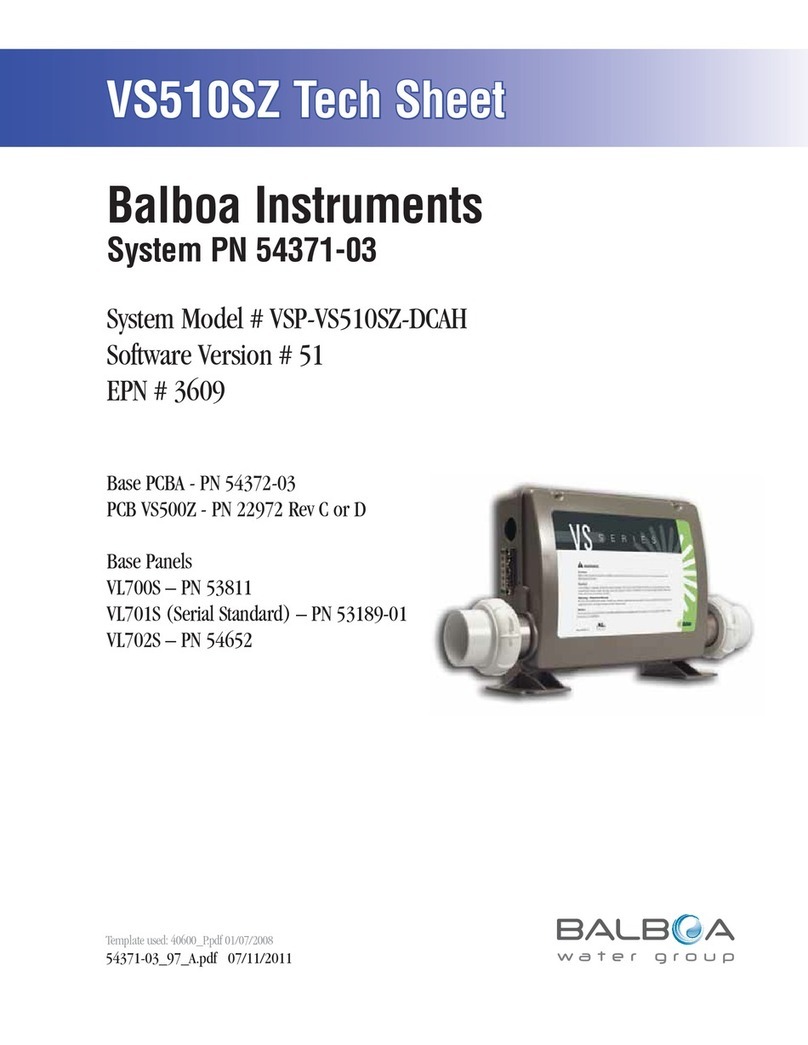
Balboa Instruments
Balboa Instruments VSP-VS510SZ-DCAH Tech sheet
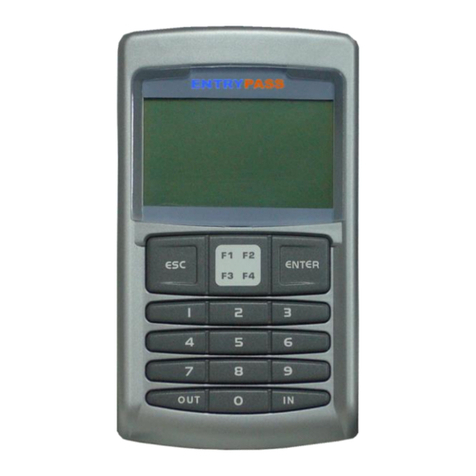
ENTRYPASS
ENTRYPASS EP.MINI Wiring guide
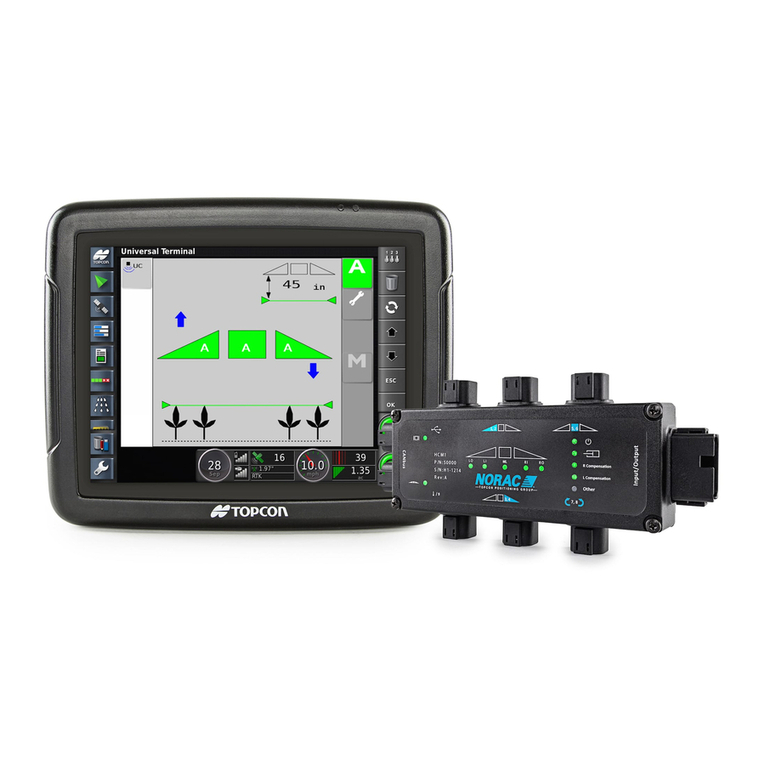
Norac
Norac UC7 installation manual
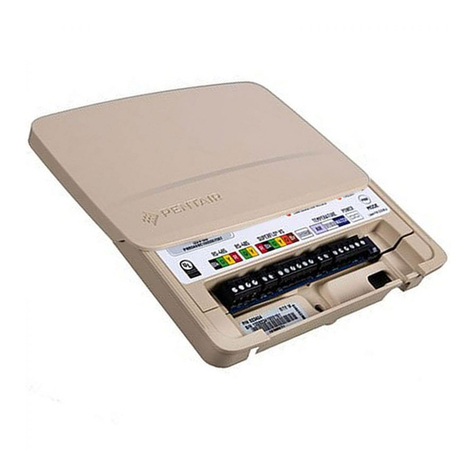
Pentair
Pentair IntelliSync 523404 user guide
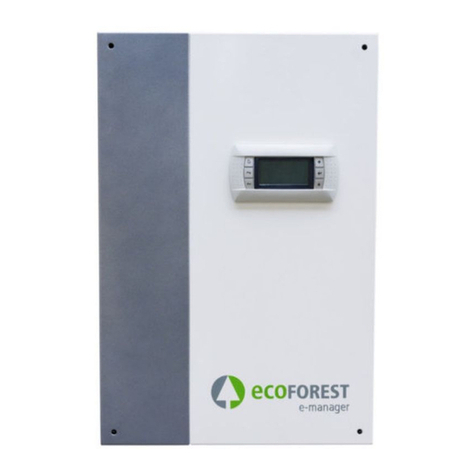
ECOFOREST
ECOFOREST ecoSMART Supervisor USER, INSTALLER AND TECHNICAL SERVICE MANUAL
Lennox
Lennox Icon Hardware Installation and System Commissioning Guide
